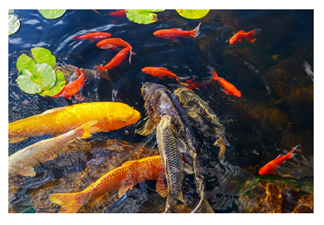Common Pond Building Mistakes
There are a lot of people who would love to build a pond in their garden, yet encounter difficulties later on because of some simple mistakes that have been made when the pond is built.
Here, we have outlined several common mistakes that you should be aware of.
.jpg)
Location is everything for a pond! The first thing you will probably consider is having the pond as a centrepiece of your garden; so not hidden away in an unused corner of the plot. But make sure this isn’t in a low area of the garden; else rainwater can run into the pond (with all the pollutants it brings) and cause your pond to overflow!
You then need to check if the pond is under a tree; we always recommend against putting a pond under a tree because of the leaves that fall into the pond and pollute it via sludge and tannins. These can adversely affect the chemicals in your pond and harm the careful, balanced ecosystem that has been established.
2. The work involved (Useful Blogs: Pond Building Guide, Pond Build 2011 Diary)
Digging a pond is really hard work and a lot of people forget this. Not only do you have to dig the first layer of soil; but depending on the depth of the pond, you may have to get into the hole and move the soil from the bottom to the top. It takes a lot of energy; so best to get a machine in if you can or ask friends and family for help!
3. Building a small Pond (How to create a Small Pond using a Container, The Importance of Wildlife Ponds and How To Build One)
The size of the pond needs to be relative to what you are using the pond for (Wildlife, Goldfish, or Koi sized fish). It’s also much easier to manage a larger pond that it is to manage a smaller pond; a lot less can go wrong with a larger pond. A bigger pond gives more room for your fish and for plants; we have also found that the chemical imbalances in a pond happen less frequently with a larger pond than for a smaller pond. You may be interested in our range of Preformed Ponds; as this may be easier to install depending on your project.
.jpg)
4. Building a Pond that’s too shallow
Like the above, you may think that building a shallow pond is easier; it’s smaller so requires less maintenance, it’s easier to dig and to manage. But a shallow pond may not be suitable for the kind of fish you are putting in.
If you are going to put fish in, you need to have the pond at a certain depth. A wildlife pond can be as shallow as you want, a Goldfish pond should be at least 60cm (2ft) deep and a Koi pond should be 1.2m (4ft) deep.
5. Building a Pond without ledges
A pond without ledges is a big no no. Ledges are useful in putting plants on, rocks to hide a liner, or to allow some wildlife animals the ability to get in and out of the pond. If your pond doesn’t have ledges and just has sloping sizes, rocks or debris will just fall to the bottom of the pond and could cause damage or it could block up equipment at the bottom of the pond.
6. Not letting the Pond adjust (Useful Blogs: New Pond Syndrome, Bacteria, How to Remove Chlorine from your Pond)
You might think that once a liner has been installed and filled, it’s time to put fish in. Right? Wrong! There are still several steps you need to take before the pond can harbour fish.
Firstly, if you have filled the pond up with tap water, you need to remove any chlorines or chloramines in the water. These chemicals make tap water safe for human consumption, but they can harm your fish. A popular dechlorinator we sell is the PondXpert Tap Tonic; if you are planning on regularly changing the water, you may want to look into a dedicated dechlorinator like the PondXpert In-Line Dechlorinator or the Evolution Aqua Detox Dechlorinator (12 Inch).
Secondly, you need to wait for your pond to generate its own ecosystem and bacteria. The pond will go through the nitrogen cycle, were bacteria changes chemicals into different chemicals; this helps to make the water safe for your fish. You then need to wait for the healthy bacteria to develop in your filter. Without treatments, this process can take up to six weeks. With treatments, the bacterial colonization process can be dramatically sped up. Popular treatments for this include the Evolution Aqua Filter Start Gel or the PondXpert Pond Gel Balls.

You need to refrain from overstocking a pond. Too many fish can suck the oxygen out of the water, create too much sludge and it will likely lead you to overfeeding the fish. The general guide for fish levels in ponds is below (1" of fish is approximately 30g):
• 3kg of Goldfish per 1000 litres of pond water e.g. a 4000 litre pond will support up to 12kgs of Goldfish
• 1kg of Koi per 1000 litres of pond water e.g. a 4000 litre pond will support up to 4kgs of Koi
8. Not enough shade (Useful Blogs: Why Temperature plays a big role in Pond Development, Pond Plants)
While ponds need a lot of sunlight (at least 4-5 hours of daylight a day), shade is particularly useful at preventing algae growth. For shade, you can build a canopy, use floating plants, hardy plants (water lilies are great for this!), artificial plants or cover nets.
If you need any assistance or have any queries, please email us on info@pondkeeper.co.uk.